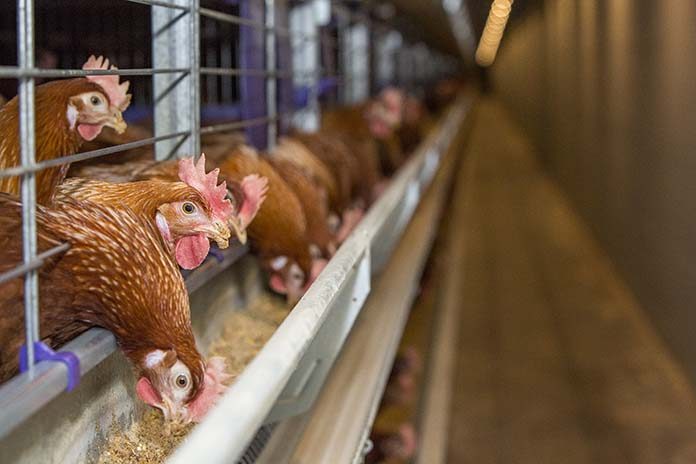
In 2010, the Institute of Medicine in the United States reviewed current literature and changed the estimated average requirement of 400 IU/day to a recommended dietary Allowance (RDA) of 600-800 IU/day in the United States (IOM, 2010). This was completed under the assumption that due to skin cancer concerns, sun exposure was minimal. To this end, few natural foods contain significant concentrations of vitamin D to meet the new recommended dietary allowances, which necessitates fortification of the diet or specific foods with vitamin D to satisfy the current and future recommendations.
Therefore, it is important to find alternative foods to increase the daily intake of vitamin D in the diet to maintain high circulating concentrations of this vital nutrient.
In 2011, USDA surveyed table egg vitamin D content and updated the value to 40 IU/egg, reflecting the increased amount of vitamin D fed to laying hens for bone and shell quality. Although this represents a tremendous increase in egg vitamin D content, raw data from the report indicated commercial content of vitamin D above 400 IU/egg showing the variation of egg vitamin D content due to dietary supplementation and the efficient transfer of lipid and lipid soluble molecules from the hen to the egg.
Hypothesis and project objective
Feeding increasing concentrations of supplemental vitamin D to laying hens will increase egg vitamin D concentrations. The objective of this proposed study was to identify the threshold of the supplemental dietary vitamin D that corresponds to the peak vitamin D content of the egg. Although 40,000 IU/kg has been demonstrated to be safe when fed to laying hens, supplementation of laying hen diets with 400,000 IU/kg has been shown to cause negative health and performance effects. This study was designed to evaluate several doses below the safe dose of 40,000 and one above the safe dose, but still well below the known toxic dose of 400,000 IU/kg.
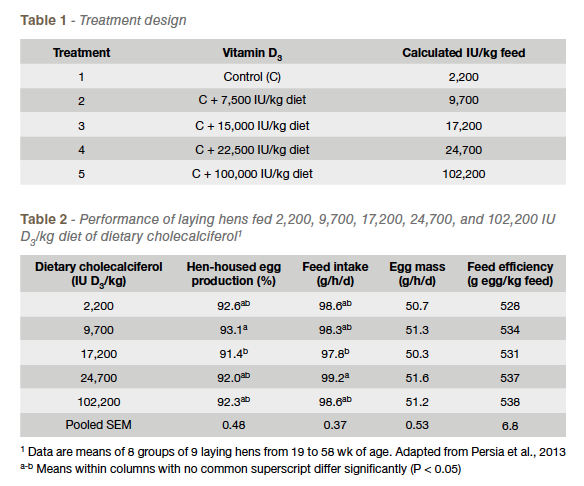
Materials and methods
Treatment design is outlined in Table 1. The experimental diets will be fed to three consecutive pens of three hens, each allowing eight replicate groups and 72 total hens for each treatment. Vitamin D3 was selected as the form of dietary supplemental Vitamin D due to cost, transfer to egg and toxicity comparisons to other vitamin D metabolites.
The experimental diets were fed to laying hens starting at the onset of the egg laying cycle and continued for the duration of the cycle, approximately 18 to 54 weeks. Hen management followed UEP guidelines (UEP, 2002) and diets were formulated to breeder recommendations. The experimental diets were mixed every two weeks to minimize the exposure of supplemental vitamin D to degradation due to feed storage. Feed was delivered daily and feed residual determined weekly. Feed intake and conversion (g eggs/g feed intake) was calculated. Hen mortality will be recorded daily.
Eggs were collected daily and production performance recorded. Eggs were saved from two consecutive days per week during the first four weeks (19-23); two consecutive days every two weeks for the next 10 weeks 23-33; and two consecutive days every four weeks for the remaining duration of the experiment (32-58). The saved eggs were weighed to determine egg size and mass produced. Sixteen eggs per experimental treatment (two from each replicate group) were be broken and separated to determine shell, yolk and albumin weights. The egg yolks were pooled to determine total lipid, phospholipid, fatty acid composition and total unsaponifiable matters. Egg yolks were pooled to result in four replicate samples for Vitamin D determination by HPLC. The shells were used to determine shell thickness and Haugh units were measured and yolk color will be scored on a color fan. The remaining eggs were used to determine yolk physical and functional properties, including viscosity of raw yolk, and emulsification parameters.
At the conclusion of the experiment, all hens were visually inspected for keel bone integrity and soft tissue calcification to determine effects of long-term feeding of supplemental vitamin D on skeletal and soft tissue integrity. The right tibia was collected from three birds per replicate group to determine fat-free tibia bone ash as an indicator of general skeletal health and Ca and P status.
Statistics on the performance data and egg weights, egg component weights, Haugh units and yolk color scores were analyzed using ANOVA with repeated measurements. Performance data were analyzed with new diet mixing every two weeks and egg data were analyzed when eggs were collected at either 1, 2 or 4 week intervals. There were no interactions over time so main effects are presented. If significance was detected (P < 0.05), Tukey’s honestly significant test was employed to separate treatment means. Egg quality characteristics and vitamin D content and transfer rates were analyzed using ANOVA.
Results and discussion
Observation of the performance data from 19 to 58 weeks suggests no difference among the various concentrations of supplemental vitamin D. Egg production over the 40-week period was between 91.4 and 93.1% hen housed, without any significant differences among the control fed birds and vitamin D supplemented birds, although there were some inconsistent differences among the vitamin D supplemented birds. Feed intake again showed no significant differences among the control feeds and the vitamin D supplemented feeds, with over all feed intake ranging from 91.8 to 99.2g per hen per day. There were no differences in daily egg mass or overall feed efficiency (g egg/kg feed intake). These data are in agreement with previous data that reported no differences in performance among control fed birds and birds supplemented with 5,000 to 15,000 IU/kg vitamin D. Egg weights were not significantly different among the treatments, but some egg component weights were significantly different (Table 3). As with total egg weight, albumen weights were not different among treatments, but egg yolk weight was significantly increased from the birds receiving 24,700 IU/kg in comparison to both the control (2,200 IU/kg) and the 102,200 IU/kg treatments. There were significant differences among the shell weights of the 24,700 and 102,200 IU/kg supplemented hens, but none of the experimental treatments were different from the eggs of the control fed birds. These results are in general agreement with Browning and Cowienson (2014) where up to 10,000 IU/kg vitamin D did not significantly alter egg weights, shell breaking strength, or yolk weights. Haugh units, a measurement of albumen protein quality was not significantly changed by vitamin D treatment, but yolk color was significantly increased with the 102,200 IU/kg vitamin D treatment (Table 3). Yolk color is the first response measured where the highest concentrations of vitamin D fed might have altered the response, but the question remains, is this modest, but significant difference in yolk color indicative of negative performance?
As with Haugh units, there were no significant differences among egg yolk moisture content, unsaponifiable matter, viscosity, and emulsification properties due to hen dietary vitamin D treatment (Table 4). The emulsion and emulsification data are supported in the literature as Mattila and co-workers (2003) did not show any differences in these measurements with whole eggs. At the end of the 40-week experiment, hen tibia bones were collected for fat-free ash determination. As with performance there we no effects of supplemental dietary vitamin D on fat-free tibia ash and all bones appeared normal and healthy.
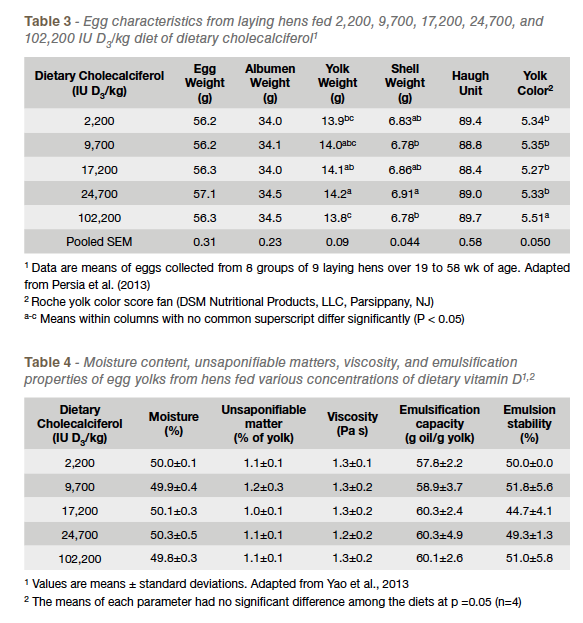 The performance and egg quality data presented might suggest that up to 102,200 IU/kg of vitamin D is safe and efficient to feed to laying hens, but it is also important to consider general vitamin D metabolism and regulation before drawing conclusions.
The performance and egg quality data presented might suggest that up to 102,200 IU/kg of vitamin D is safe and efficient to feed to laying hens, but it is also important to consider general vitamin D metabolism and regulation before drawing conclusions.
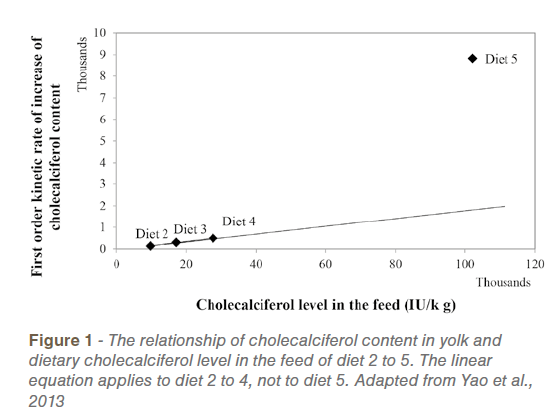 The feeding of vitamin D to laying hens for 40 weeks resulted in a linear increase in egg yolk vitamin D content from the 9,700 to the 24,700 IU/kg feed fed birds (Figure 1), validating previous data and expanding the range of response to almost 25,000 IU/kg. But looking at the transfer of vitamin D from the diet to the egg yolk for the 102,200 IU/kg treatment it is clear that more vitamin D is being transferred to the yolk at these high concentrations of dietary vitamin D than in any of the other treatments. This point is made abundantly clear when considering the vitamin D transfer rates of the five dietary treatments (Figure 2). The lowest rate was noted in the control eggs were approximately 5% transfer occurred, the 9,700 to 24,700 IU/kg treatments resulted in a significant increase in transfer rate, but at a controlled rate of 8 to 9%. Once the 102,200 IU/kg diets were fed, transfer rate was uncontrolled at approximately 25 to 30% transfer of vitamin D from the diet to the egg yolk. This break down of vitamin D metabolism does suggest at least the beginning stages of toxicity although performance over a 40-week experiment was not negatively altered.
The feeding of vitamin D to laying hens for 40 weeks resulted in a linear increase in egg yolk vitamin D content from the 9,700 to the 24,700 IU/kg feed fed birds (Figure 1), validating previous data and expanding the range of response to almost 25,000 IU/kg. But looking at the transfer of vitamin D from the diet to the egg yolk for the 102,200 IU/kg treatment it is clear that more vitamin D is being transferred to the yolk at these high concentrations of dietary vitamin D than in any of the other treatments. This point is made abundantly clear when considering the vitamin D transfer rates of the five dietary treatments (Figure 2). The lowest rate was noted in the control eggs were approximately 5% transfer occurred, the 9,700 to 24,700 IU/kg treatments resulted in a significant increase in transfer rate, but at a controlled rate of 8 to 9%. Once the 102,200 IU/kg diets were fed, transfer rate was uncontrolled at approximately 25 to 30% transfer of vitamin D from the diet to the egg yolk. This break down of vitamin D metabolism does suggest at least the beginning stages of toxicity although performance over a 40-week experiment was not negatively altered.
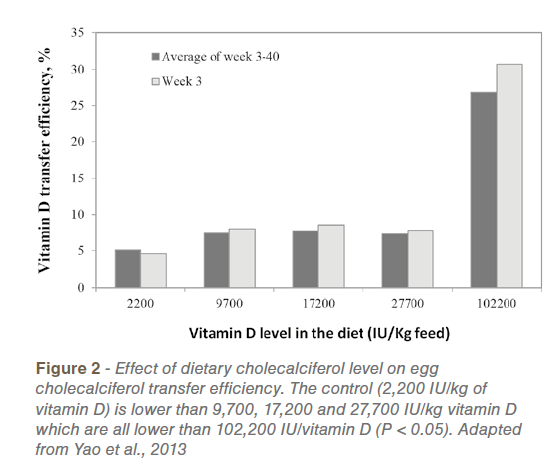 These results add to our estimate of vitamin D toxicity data and help to better define those rates in laying hens. Currently the highest concentration of vitamin D that has been fed without noticeable toxicity effects has been 40,000 IU/kg feed (Morrisey et al.,1977), and the remaining research reports and data presented here all agree that concentrations under 40,000 IU/kg are not toxic to laying hens. There are few data points collected above this threshold, but Morrisey and co-workers (1977) did evaluate 400,000 IU/kg with vitamin D toxicity noted including calcification of soft tissue.
These results add to our estimate of vitamin D toxicity data and help to better define those rates in laying hens. Currently the highest concentration of vitamin D that has been fed without noticeable toxicity effects has been 40,000 IU/kg feed (Morrisey et al.,1977), and the remaining research reports and data presented here all agree that concentrations under 40,000 IU/kg are not toxic to laying hens. There are few data points collected above this threshold, but Morrisey and co-workers (1977) did evaluate 400,000 IU/kg with vitamin D toxicity noted including calcification of soft tissue.
The current data would suggest that 102,200 is beginning to become toxic due to the failure of the model to control transfer of dietary vitamin D into the yolk of the egg. Therefore, at this time we can conclude that 40,000 IU vitamin D/kg feed or less is safe and tolerable for laying hens, but dietary concentrations above 100,000 are becoming toxic to the hens. The data presented in this document are based on either short or long term feeding in adult animals and do not reflect that application of high vitamin D feeding over the pullet rearing phase limiting interoperation. It would be interesting to better understand the long term growth, performance and health effects of higher vitamin D feeding over the entire life cycle of the laying hen, not just the adult egg production phase.
References are available on request
Presented at the 2017 Australian Poultry Science Symposium, New South Wales, Australia

















